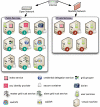Adoption and Adaptation of caGrid for CTSA
- PMID: 21347169
- PMCID: PMC3041578
Adoption and Adaptation of caGrid for CTSA
Abstract
The field of informatics has been going through a rapid change over the past decade. New technologies such as grid computing[1-5] and knowledge anchored data, combined with major funding and growing community thrusts aimed at creating a richer multi-institutional research and clinical environment such as caBIG™[6-8] (Cancer Bioinformatics Grid), BIRN[9] (Bioinformatics Research Network), and CTSA(Clinical and Translational Science Awards) have lead to new ways to bring together information across institutional boundaries. This had lead to service oriented architectures based developments in creating semantically interoperable data and analytical services to increase speed, efficiency, and outcome of clinical and research efforts spanning the fields of medicine. The TRIAD (Translational Informatics and Data Management Grid) System, which will be used as the middleware system enabling the OSU CTSA to create a scalable, secure, and knowledge anchored data sharing environment, will adopt and adapt the caGrid infrastructure designed for the caBIG™ program.
Figures
Similar articles
-
A roadmap for caGrid, an enterprise Grid architecture for biomedical research.Stud Health Technol Inform. 2008;138:224-37. Stud Health Technol Inform. 2008. PMID: 18560123 Free PMC article.
-
caGrid: design and implementation of the core architecture of the cancer biomedical informatics grid.Bioinformatics. 2006 Aug 1;22(15):1910-6. doi: 10.1093/bioinformatics/btl272. Epub 2006 Jun 9. Bioinformatics. 2006. PMID: 16766552
-
TRIAD: The Translational Research Informatics and Data Management Grid.Appl Clin Inform. 2011 Aug 17;2(3):331-44. doi: 10.4338/ACI-2011-02-RA-0014. Print 2011. Appl Clin Inform. 2011. PMID: 23616879 Free PMC article.
-
CTSA-IP: a solution to identifying and aggregating intellectual property across the NIH Clinical Translational Science Award (CTSA) consortium of biomedical research institutes.Clin Transl Sci. 2011 Oct;4(5):328-31. doi: 10.1111/j.1752-8062.2011.00308.x. Clin Transl Sci. 2011. PMID: 22029803 Free PMC article. Review.
-
Changing from computing grid to knowledge grid in life-science grid.Biotechnol J. 2009 Sep;4(9):1244-52. doi: 10.1002/biot.200800073. Biotechnol J. 2009. Retraction in: Biotechnol J. 2011 Jan;6(1):125. doi: 10.1002/biot.201190008. PMID: 19579217 Retracted. Review.
Cited by
-
Sustainability Through Technology Licensing and Commercialization: Lessons Learned from the TRIAD Project.EGEMS (Wash DC). 2014 Jul 17;2(2):1075. doi: 10.13063/2327-9214.1075. eCollection 2014. EGEMS (Wash DC). 2014. PMID: 25848609 Free PMC article.
-
Sharing behavioral data through a grid infrastructure using data standards.J Am Med Inform Assoc. 2014 Jul-Aug;21(4):642-9. doi: 10.1136/amiajnl-2013-001763. Epub 2013 Sep 27. J Am Med Inform Assoc. 2014. PMID: 24076749 Free PMC article.
References
-
- Foster I, Kesselman C. The grid : blueprint for a new computing infrastructure. xxiv. San Francisco: Morgan Kaufmann Publishers; 1999. p. 677.
-
- Foster I. Service-oriented science. Science. 2005;308(5723):814–817. - PubMed
-
- Foster I. The grid: Computing without bounds. Scientific American. 2003;288(4):78–85. - PubMed
-
- Foster I, Kesselman C. Globus: A metacomputing infrastructure toolkit. International Journal of Supercomputer Applications and High Performance Computing. 1997;11(2):115–128.
-
- Foster I, Kesselman C, Tuecke S. The anatomy of the grid: Enabling scalable virtual organizations. International Journal of High Performance Computing Applications. 2001;15(3):200–222.
Grants and funding
LinkOut - more resources
Full Text Sources
Miscellaneous


